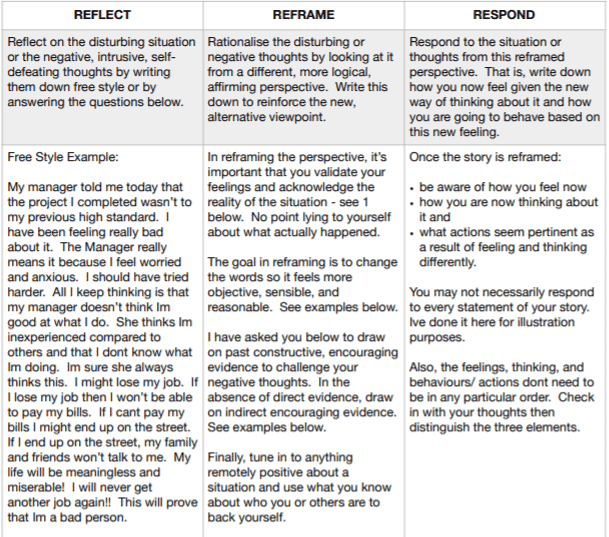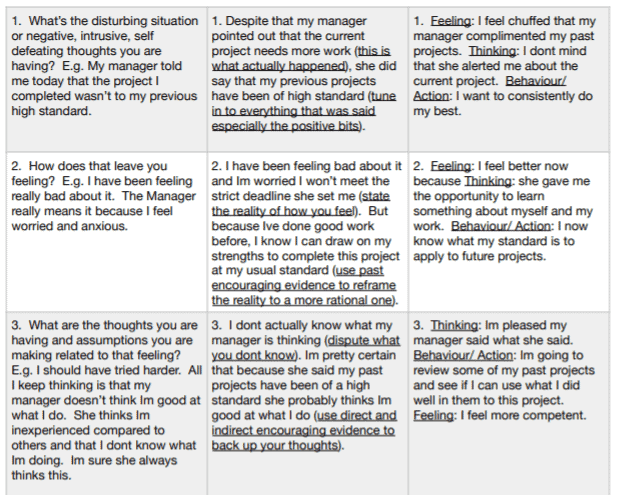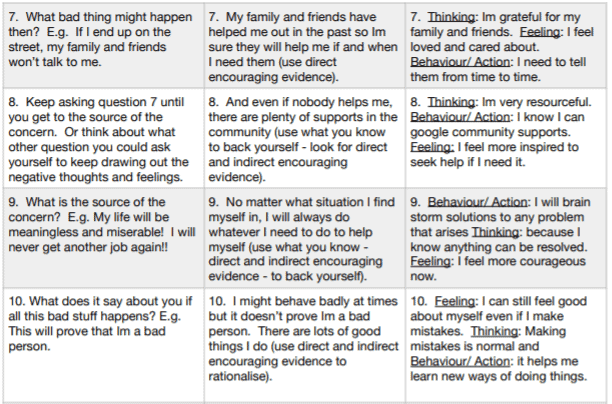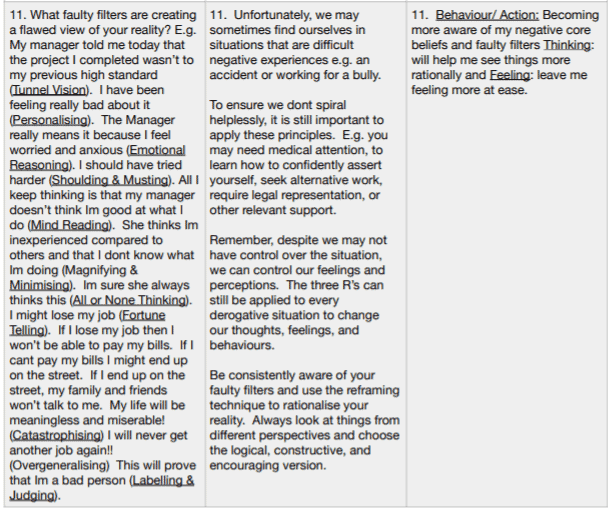Apologies for the delay in sending another newsletter. Life has been hecticly different during the COVID-19 lockdown period as I have had to reassess how I run my business. I’m pleased that I have automated many of my processes and reviewed old ways of doing things. Sometimes with the bad comes the good. I hope many have found this over the last three months.
Today I thought that what might be helpful is to offer you a strategic technique I have been using in therapy this year. It has been especially helpful to clients struggling with isolation and all the COVID-19 changes. I developed this technique to simplify the cognitive methods usually used to help people reframe their negative thoughts. However, the principles are pretty much the same.
I have explained the techniques quite comprehensively, step by step. It may look a bit overwhelming at first but, if you take the time to follow the steps, I’m sure you will find it works. I would certainly appreciate some constructive feedback if you found it helpful or not
Using the Three R’s to Reflect, Reframe, and Respond Constructively
Negative Core Beliefs
- Negative Core Beliefs are based on false decisions we made in childhood or adolescence in response to something bad that happened.
- These false rules, biases, and assumptions resulted from some perceived threat to our self worth, our values, our safety, competence, autonomy, belonging, and how well loved we felt.
- In addition to negative core beliefs, our mind creates faulty filters that can lead to flawed views of reality. These faulty filters, over time, become thought habits that distort the incoming information from the outside world in a way that ca cause us great distress. See the list below.
- We then assimilate these irrational ways of thinking in adulthood to, seemingly, protect ourselves.
- However, negative ways of thinking can impact how we feel about ourselves. We may find that we judge ourselves as bad, unworthy, or not good enough.
These inaccurate beliefs and faulty filters then dictate how we behave. That is, the things we do or don’t do to live up to the expectations of the rules and assumptions we set up.
- The assumption we often make as adults is that the situation or a person makes us feel bad – this is the triggering situation.
- The reality is, it’s the way we are thinking – yes, our own thoughts that leave us feeling bad.
- The bad news is that if it was the triggering situation, then we would have no control over it. In fact, it’s often how we feel because that’s probably how we felt in childhood or adolescence.
- The good news is that because it is our negative thoughts that influence our emotions and behaviours, we do have control over our thoughts, therefore we can change them.
- Having said that, changing our core beliefs and faulty filters takes time. It requires the challenging of old self-defeating rules and assumptions to replace them with new constructive cognitions so we are left with positive beliefs.
- Keep in mind that we are naturally biased towards negative perceptions for survival purposes. This is driven by our non-conscious mind, which is a million times stronger than our conscious mind. Hence why there’s often a ‘push pull’ effect when we are making attempts to change.
- Don’t despair because the conscious mind can override the non-conscious mind. It only takes 21 days to change a thought or behaviour, 2 months to change a habit, and 3 months to consolidate that changed habit.
- With an effective reframing tool it doesn’t take long. It simply takes practice, perseverance, and repetition!
FAULTY FILTERS
- Mind Reading – assuming that others are thinking terrible things about us
- Fortune Telling – negatively predicting how things are going to work out
- Personalising – disparagingly making it about us, self-blaming, putting ourselves down
- Catastrophising – exaggerating the worst case scenario
- All or None Thinking – evaluating situations in extremes with no consideration to ‘shades of grey’
- Shoulding and Musting – interpreting everything through unrealistic expectations
- Overgeneralising – assuming that negative events happen all the time
- Labelling & Judging – using negative labels and judgements to describe ourselves and others
- Emotional Reasoning – inaccurately thinking that just because we feel it, it is true
- Tunnel Vision – focusing on the negative part of a situation and overlooking the positive
- Magnifying & Minimising – amplifying others’ positive attributes and down playing our own
There are a variety of methods to identify and challenge destructive ways of thinking. I developed the three R’s to simplify some of these cognitive methods but the principles are the same. That is, identify derogative thoughts, notice the negative impact they are having on your mood and behaviours, change the thoughts so they are more constructive, and now notice the positive impact.
In the table below, I have provided an example of how to apply the three R’s to change from self-defeating to a more self-affirming perspective. It is comprehensive on purpose because some of my past clients have felt confused by the process and asked for more detailed instructions. For those of you who don’t need an example, go straight to the link of the second table.




Click on the below link to view a simpler description on using the three R’s to change the derogative ways we feel and think about situations or ourselves.


